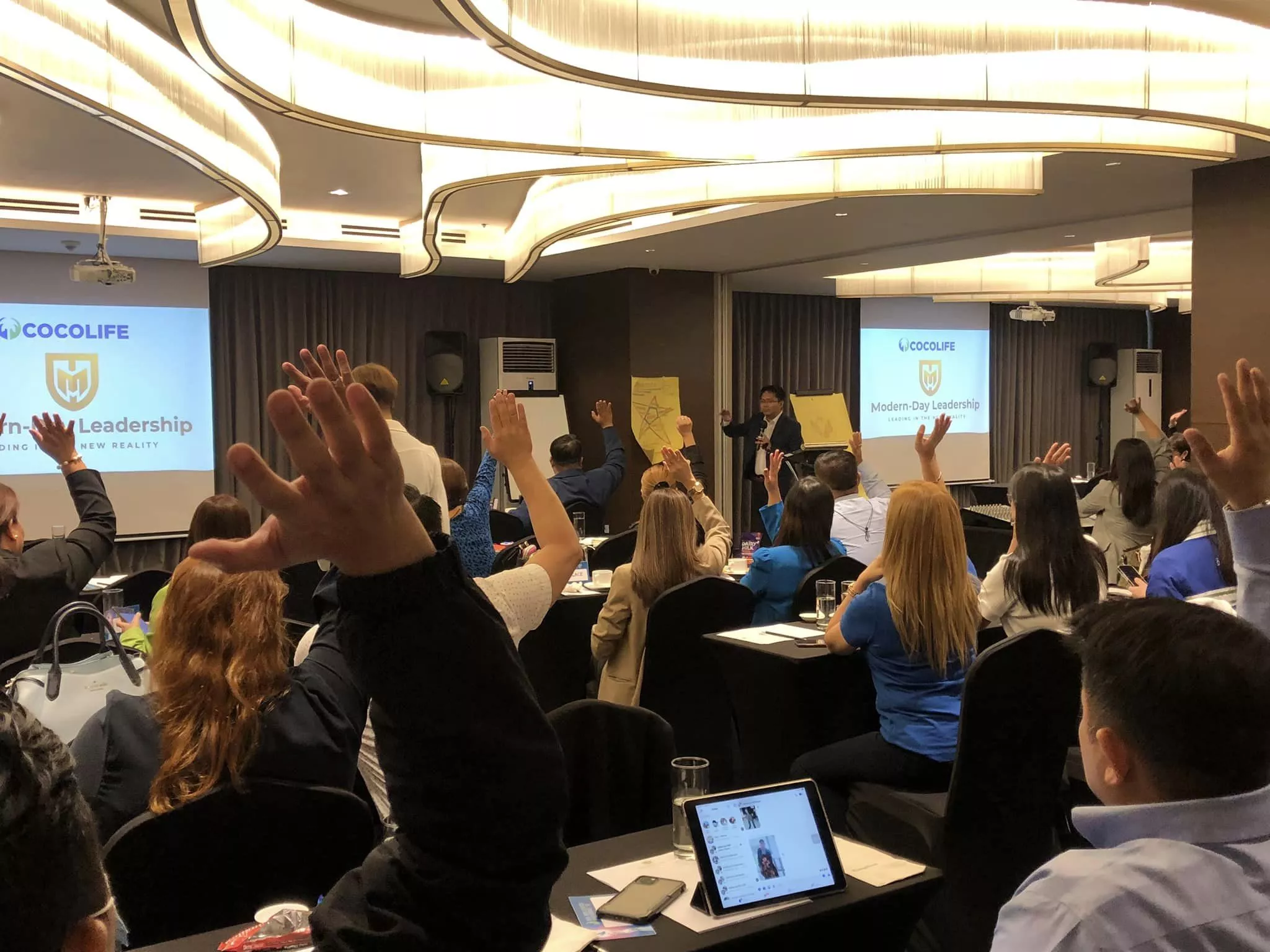Leadership in Virtual Teams: Strategies For Remote Engagement
Leadership in virtual teams is a critical factor determining remote collaboration's success and efficiency in today's digitally connected world. ‘
As organizations increasingly adopt virtual work environments, the need for effective leadership strategies that cater to the unique dynamics of remote teams has never been more pronounced.
This article delves into the nuances of virtual leadership, exploring how it differs from traditional in-person leadership, the pivotal role of a leader in a virtual setting, and the best practices for leading a team that is not bound by physical office space.
I manage two of my four companies, SharpRocket and Rainmaker, and have a work-at-home (virtual work) team setup. That said, I’ve understood what’s effective in leading virtual teams to increase business performance and achieve sustainable success goals for the organization.
Why is Leadership important in Virtual Teams?
Establishing Vision and Purpose
Leadership in virtual teams is paramount for delineating a clear vision and purpose. The risk of team members veering into isolated workflows is significant in environments without physical interaction.
A leader's role is to articulate a unifying mission, ensuring that, despite geographical disparities, each member is synchronized with the team's overarching goals, fostering a collective sense of direction and purpose.
Cultivating Trust and Accountability
Leadership is essential for nurturing trust and accountability in the virtual realm, where the potential for feeling disconnected is amplified. Leaders must adeptly create a transparent environment where reliance on one another is paramount.
By consistently communicating, acknowledging individual efforts, and setting up robust accountability frameworks, leaders lay the groundwork for a trust-centric culture, which is indispensable for virtual team efficacy.
Facilitating Communication and Collaboration
The absence of in-person interactions in virtual teams can lead to miscommunications and collaborative hurdles. Excellent leaders are great at utilizing technology to surmount communication barriers, ensuring that team members have access to and are proficient in using digital tools for effective collaboration.
This involves not only choosing the right technological aids but also fostering an environment where open and efficient communication is the norm.
Driving Engagement and Motivation
Leadership is crucial in maintaining engagement and motivation within virtual teams, where the remote nature of work might induce feelings of detachment. Leaders need to create avenues for engagement proactively, be it through virtual team-building exercises, regular updates, or celebrating collective achievements.
By keeping engagement levels high. Leaders ensure sustained motivation and commitment among team members, vital for the team's success and well-being.
How Is Virtual Leadership Different than In-Person Leadership?
Virtual and in-person leadership are two distinct paradigms, each with unique challenges and requirements. While the core principles of effective leadership remain constant—such as clear communication, trust-building, and vision-setting—the transition from a physical to a virtual environment necessitates a shift in strategies and behaviors.
Communication Nuances
Leaders cannot rely on physical presence or non-verbal cues in a virtual setting, which are integral to in-person communication. Virtual leaders must convey tone, intent, and emotion through written and digital communication channels.
This requires heightened clarity and intentionality in message delivery to avoid misunderstandings and ensure that the team remains aligned and informed.
Building Relationships and Trust
The absence of face-to-face interactions in virtual teams can impede the natural development of relationships and trust. Virtual leaders must cultivate trust proactively by being consistent, reliable, and transparent.
To foster community and camaraderie, they must create opportunities for team members to connect personally, such as virtual coffee breaks or team-building activities.
Monitoring Performance and Engagement
Traditional performance monitoring and engagement methods could be more effective in a virtual environment. Leaders must do more than walk around the office to get a sense of team morale or productivity. Instead, they must leverage digital tools and regular check-ins to gauge team performance and well-being.
This requires a more data-driven approach, using project management tools and virtual feedback mechanisms to track progress and address issues promptly.
Adapting Leadership Styles
Virtual leaders must be flexible and adaptable in their leadership styles. The one-size-fits-all approach is less practical in a virtual context, where team members may have diverse working styles, time zones, and cultural backgrounds.
Leaders must tailor their approach to suit individual team members, providing personalized support and flexibility to accommodate different needs and preferences.
Leveraging Technology
Effective virtual leadership is contingent on the appropriate use of technology. Leaders must select the right tools for communication, collaboration, and project management and ensure that the team is proficient in using these tools. This may involve leadership training and support to team members to enhance their digital literacy and provide seamless collaboration.
While the foundational qualities of good leadership remain consistent, virtual leadership demands additional competencies and a nuanced understanding of the digital workspace.
Virtual leaders must excel in communication, build trust without physical presence, adapt their leadership style, leverage technology effectively, and find innovative ways to monitor and boost team performance and engagement.
By mastering these aspects, leaders can overcome the challenges of the virtual environment and lead their teams to success.
Which leadership style is best for virtual teams?
Identifying the most effective leadership style for virtual teams is crucial for fostering a productive and cohesive environment. With its unique challenges and dynamics, the virtual context often benefits from a blend of leadership styles rather than a one-size-fits-all approach.
However, certain styles have proven particularly conducive to the virtual setting.
Transformational Leadership
Transformational leadership is highly effective in virtual teams. This style is characterized by leaders who inspire and motivate their team members by creating a vision, encouraging innovation, and fostering an environment of trust and respect.
Transformational leaders focus on developing their team members, empowering them to take initiative and contribute creatively to the team's goals. This style is particularly beneficial in a virtual context, where motivation and engagement can wane without the physical presence of a unifying leader.
Servant Leadership
Servant leadership is another style that resonates well with virtual teams. Servant leaders prioritize the needs of their team members, focusing on building relationships, promoting collaboration, and ensuring the well-being of their team. In a virtual environment, where direct oversight is limited, a servant leader's emphasis on support and empowerment can enhance team autonomy and satisfaction.
By putting their team's needs first, servant leaders can foster a sense of loyalty and commitment, which is crucial for remote team cohesion.
Democratic Leadership
The democratic leadership style involves team members in decision-making processes and is particularly effective in virtual settings. This approach encourages participation and ensures that team members feel valued and heard, which can be challenging to achieve remotely.
By soliciting input and fostering a collaborative decision-making environment, democratic leaders can enhance team engagement and commitment, leading to more innovative solutions and a stronger sense of unity among dispersed team members.
Situational Leadership
Given the dynamic nature of virtual teams, situational leadership is also a valuable approach. This style allows leaders to adapt their strategy based on their team members' context and needs. In virtual teams, where individual circumstances can vary widely (e.g., different time zones, cultural backgrounds, and home environments), the flexibility of situational leadership can be particularly beneficial.
Leaders who can adjust their style to provide guidance, support, or autonomy, as needed, can effectively manage virtual teams' diverse and fluid nature.
While no single leadership style is the panacea for all virtual team challenges, a combination of transformational, servant, democratic, and situational leadership approaches tends to be most effective.
The key is for leaders to be adaptable, empathetic, and communicative, tailoring their approach to their virtual team's unique needs and dynamics. Doing so can foster an environment of trust, collaboration, and high performance, even without physical proximity.
The Role of a Leader in a Virtual Team
In the context of virtual teams, the role of a leader extends beyond traditional management functions to encompass a range of responsibilities tailored to the digital environment. These responsibilities are critical in navigating the unique challenges posed by remote work, ensuring team cohesion, and driving performance despite the lack of physical proximity.
Visionary and Strategic Navigator
A leader in a virtual team acts as a visionary, setting a clear and compelling direction that aligns with the organization's goals. They are responsible for communicating this vision in a way that resonates with team members across various locations, ensuring everyone is working towards a common objective.
The leader must also be a strategic navigator, adept at adjusting plans as needed and guiding the team through changes and challenges.
Communication Champion
Effective communication is the linchpin of successful virtual teams. A leader must excel in clear, concise, and consistent communication, utilizing various digital tools to ensure messages are understood and retained.
They must establish and maintain open lines of communication, encouraging team members to share ideas, concerns, and feedback. This role involves disseminating information and actively listening to team members, fostering an environment where everyone feels heard and valued.
Trust Builder and Relationship Cultivator
Building trust and relationships in a virtual setting requires intentional effort. Leaders must create a culture of trust where team members feel confident in the reliability and integrity of their colleagues and the organization. This involves demonstrating trustworthiness through actions, such as following through on commitments and respecting team members' work and opinions.
Leaders should facilitate opportunities for team members to connect and build relationships beyond work-related tasks, which is vital for team cohesion and morale.
Performance and Engagement Facilitator
A virtual team leader monitors and drives team performance and engagement. This involves setting clear expectations, providing regular feedback, and recognizing achievements. Leaders must be adept at using digital tools to track progress and identify issues that may hinder team performance.
They also play a crucial role in motivating and engaging the team, which can be challenging in a remote environment. This includes addressing signs of isolation or disengagement and ensuring team members feel valued and integral to the team's success.
Adaptability and Crisis Manager
The dynamic nature of virtual teams requires leaders to be highly adaptable and capable of managing crises and making quick decisions. They must be prepared to tackle technical issues, mediate conflicts that arise in remote interactions, and adapt to the evolving needs of the team and the organization.
Being proactive in anticipating challenges and responsive in addressing them is crucial for maintaining team stability and performance.
In essence, the role of a leader in a virtual team is multifaceted, encompassing the duties of a visionary, communicator, relationship builder, performance manager, and adaptability expert.
Leaders can effectively fulfill these roles and ensure their virtual teams are productive, cohesive, and aligned with the organization's objectives, even without a traditional office environment.
Best Practices for Leading a Virtual Team
Leading a virtual team effectively requires combining traditional leadership skills and new strategies tailored to the digital environment. Here are some best practices that can help leaders foster a productive, engaged, and cohesive virtual team:
1. Establish Clear Communication Protocols
Effective communication is the cornerstone of successful virtual teamwork. Leaders should establish clear communication protocols, including the preferred channels for different types of communication, response time expectations, and guidelines for virtual meetings.
Ensuring every team member understands how and when to communicate can prevent misunderstandings and ensure smooth collaboration.
2. Set Explicit Goals and Expectations
In a virtual setting, the absence of physical presence can lead to ambiguity regarding roles, responsibilities, and objectives. Leaders should set explicit goals and clearly define each team member's responsibilities.
Regularly revisiting these goals and expectations can help keep the team aligned and focused, even as circumstances evolve.
3. Foster a Strong Team Culture
Building a strong team culture is vital for virtual teams, where the lack of face-to-face interaction can lead to feelings of isolation. Leaders should encourage a culture of openness, inclusivity, and mutual support.
Celebrating milestones, acknowledging individual and team achievements, and facilitating informal interactions can strengthen team bonds.
4. Leverage Technology Effectively
Choosing the right technology is crucial for virtual team success. Leaders should ensure the team has access to practical communication, collaboration, and project management tools.
It's also essential to provide training and support to ensure all team members are comfortable and proficient with these tools.
5. Encourage and Facilitate Collaboration
Promoting collaboration in a virtual team can be challenging but is essential for harnessing the team's collective expertise. Leaders should create opportunities for team members to collaborate on projects, share knowledge, and provide feedback to each other.
This can involve structured collaboration sessions and encouraging more spontaneous, informal collaboration.
6. Provide Regular Feedback and Recognition
Without physical cues and spontaneous interactions, providing regular feedback and recognition becomes even more critical in a virtual environment.
Leaders should make a concerted effort to acknowledge individual contributions and provide constructive feedback, helping team members feel valued and motivated.
7. Prioritize Trust and Transparency
Trust is a critical element of effective virtual teams. Leaders can foster trust by being transparent about decisions, sharing information openly, and showing consistency in their actions and communications.
Encouraging team members to share their thoughts and concerns can also contribute to a culture of trust and transparency.
8. Support Work-Life Harmony
Blurring work and personal life is a common challenge in virtual teams. Leaders should emphasize the importance of work-life balance, respect boundaries, and encourage team members to take time off when needed.
Acknowledging and addressing the challenges of remote work can help team members manage their well-being and stay productive.
By implementing these best practices, leaders can navigate the unique challenges of virtual team leadership, fostering an environment where team members are engaged, collaborative, and aligned towards common goals despite the physical distances that separate them.
How To Be A Good Leader: 28 Essential Skills For Effective Leadership
I’ve been a business leader and active volunteer of non-profit organizations for over a decade, and I’ve seen leadership as an integral success factor for any team and organization.
If you want to impact and influence people around you significantly, here’s your guide on how to be a good leader.
What is leadership?
Leadership is influencing people on their attitude and skills to succeed in their performance.
By developing their character and helping them achieve results, you can establish teams to collaborate, pursue, and achieve the organization's goals.
Leadership Training in the Philippines
To continue your leadership growth, you must invest in the Philippines' best leadership training programs.
Rainmaker, a consultancy brand of SharpRocket, owned and operated by Venchito Tampon, one of the best corporate trainers in the country, offers his best-selling corporate training program, Modern-Day Leadership.

Modern-day leadership program focuses on values-based leadership that deals with the five pillars that every organization leader must acquire to be more effective in their respective spheres of influence.
Contact us to get a free quote on our leadership training program. We tailor the training to the needs and context of your company.
Importance of Leadership
Aside from the apparent reason that leadership plays a vital role in growing the organization, there are more detailed benefits of investing in leadership for yourself.
1. Healthy Work Environment
Leadership can help promote a healthy work environment by creating “psychological safety” in its atmosphere. When people feel safe asking questions, suggesting ideas, and bringing themselves out at work, they get to do better in their jobs.
At most, they would want to engage more in the workplace as they find themselves secure enough to work with their bosses (leaders).
Leadership can positively change how the next generation (Generation Z) of professionals perceive the workplace. Great leaders can retain these young generations and, better yet, help them grow inside the organization.
2. Succession Planning
Transitions and changes happen inside any organization. Whether there is a replacement for new managers or executives or a sudden change in the organizational structure, succession planning must be prepared for the organization's members.
Effective leadership helps prepare members (rank-and-file employees, managers, supervisors, and especially people in the Human Resources department) to take over vacant positions in the company.
3. Low Turnover
With the rise of side hustle (freelancing economy), new job opportunities, work-from-home setup, and low barriers to entrepreneurship, some companies have had a high turnover.
And aside from the reasons above, some employees get frustrated with their working relationships (that they can’t get along with their bosses). This leads to high turnover (the rate at which employees leave the company).
When managers and executives learn effective leadership, they can engage their employees better through effective regular coaching and internal career development plans, leading to less likelihood that their employees will leave the company.
4. Business Results and Performance
Leadership isn’t only inspiring people to become better. It is also guiding them towards getting results in their jobs.
By doing so, you allow them to experience rewards and promotions inside the organization without having to manipulate their minds to do day-to-day work.
When leaders walk the talk, the people under them see exactly the results the leaders perform. Thus, it allows the team members to act on instructions and achieve the results from tasks that they want.
5. Community Impact
Leadership also impacts the community. Bringing positive change to stakeholders and people in society by having leaders change their perspectives is possible.
Community impact, particularly in the government and non-profit sectors, has much to do with how leaders are trained in their respective circles.
6. Work and Life Harmony
Effective leadership is understanding that life isn’t just all about work. That leadership transcends even to personal lives. The best way to test the true leadership of a person is how they behave at home.
How leaders deal with their closest members in the family is a significant determinant of their success in their careers.
Leadership Context in the Philippines
The context of Filipino leadership is quite different from Western principles. Western leadership is leaning towards ” influence,” as Dr. John Maxwell, a famous leadership expert, personally described leadership.
We, as Filipinos, are less likely to be influential and somewhat more empathetic (“malasakit”).
We admire and follow leaders who are empathetic and considerate of other people’s needs and challenges. Influence is defined as being more caring and relational than instructional and delegation in leadership approaches.
Leadership VS Management
Manage things. Lead people.
This is the fundamental difference between the two. While management is focused on improving processes, systems, and tasks, leadership heavily relies on how to make people more effective in the workplace. Its goal is to develop people.
Does a manager need only to be a leader, not a manager?
Not so. Any ranking position must be both a manager and a leader. They must know how to be good at handling people while learning how to be efficient in processes. These two are vital in getting results for their teams and the organization.
How To Be A Good Leader: 28 Essential Skills For Effective Leadership
Leadership takes time. It requires constant improvement to see spots of growth opportunities and become the person people desire to be for other people.
Here are 28 qualities and characteristics of a good leader. See which ones you already have and what qualities you must improve upon.
1. Empathy
This is the most essential trait of any good leader, particularly in the context here in the Philippines, where empathy is perceived to be of the highest value.
Having “malasakit” or “empathy” is even more locally important than being influential. Leaders who have genuine concern over their associates or employees have a high leverage (or influence) on their team members.
You can practice empathy by understanding that personal life affects people’s working behavior. It isn’t easy for Filipinos to ignore personal life issues (or having troubles at home) during working hours.
A good leader who cares deeply for his team members will genuinely ask how they are doing. One good start to developing empathy is asking questions about their life outside work.
2. Resilient
Resilience is bouncing back from failures and setbacks.
Being resilient is one of the critical characteristics of a good leader, especially during the Pandemic (Covid Days) that happened for almost two years. It allows us to see the active leaders who recovered from different challenges.
A resilient leader doesn’t easily give up. They may not know what to do during tough times, but they have a never-give-up attitude that allows them to push through trials and get the win they desire.
This is critically important for teams to have a resilient mindset, especially in the ever-changing marketing needs and demands. Resilient leaders win more and dominate the industry.
3. Adaptable
Adaptability helps leaders think of new ways and strategies to innovate their work. Leaders become more innovative in their work by understanding what’s happening in the market, case of trends, new technologies, and industry updates.
Adaptable leaders allow their teams to be agile and stay ahead of the industry's competition, enabling them to grab opportunities early on.
And through this, they make themselves more powerful and be the top-of-mind teams or brands in the industry.
4. Hospitable
One of the best traits Filipinos have is their hospitality. This became why international people (foreigners) want to do business here in the Philippines because, innately, Filipinos treat their guests with warmth and generosity.
Hospitality allows leaders to build harmony among their team members, strengthen connections, and solidify teamwork.
5. Collaborative
The “Bayanihan spirit” will always be in the hearts of Filipinos. In times of distress, local leaders have a sense of camaraderie, bringing their hearts, minds, and resources to people in need.
Collaboration can lead to better business outcomes, as individual team members can absorb new ideas from their colleagues. No wonder collaborative teams can achieve peak performance at work, resulting in more rewards and promotions within the organization.
6. Humility
Without humility, leaders won’t grow. It is a fundamental trait any leader must possess to sustain success.
It is a challenge for most leaders when they have most of their achievements. There is a tendency to slack off and be complacent at work, thinking they’ve already reached their success.
Humble leaders know that success is only temporary without the desire and hunger for learning. They keep innovating by learning from other people’s suggestions (even from their associates’ ideas).
They understand that wisdom could come from any person, especially from their teams. And from those ideas, they can lead their teams effectively with knowledge and insights.
7. Visionary
Leaders have visions for themselves and their teams. Visionary leaders can propel their teams to the next level of progress, as they know they cannot stay in their current state.
The next level of growth is always yet to come. By having a vision, they would invariably seek to impact more lives through their work. This vision alone drives their purpose and turns into reality.
8. Getting Along With Others
“Pakikisama,” as most Filipinos are familiar with, is a good characteristic most Filipino leaders have.
It is natural for most people to socialize with other people. Having “pakikisama” or camaraderie allows leaders to deepen their connections with their associates. This will enable them to penetrate their people's hearts, increasing the likelihood of success of their working relationships.
It also battles against the number one reason employees leave their companies: not getting along with their bosses.
When leaders know how to connect to their team members, they increase the retention of employees inside the company.
9. Integrity
Integrity is the foundation of any leader. Integrity comes from its origin word, “integer,” meaning “whole.”
The holistic viewpoint of leadership is in the context of home, marriage, work, non-profit, or advocacies. It means that a leader is truly a leader wherever they are. They are the same person at home and work.
This mindset allows leaders, particularly in corporations, to be more aware of their strengths, weaknesses, temptations, and challenges. Looking at their character daily is an excellent start to checking their integrity.
Integrity is “walking the talk” and “talking the walk.” What you speak is what you act, and what you work is what you speak to others.
10. Patience
Patience, in its original sense, is lasting suffering. You suffer from your emotional state, being inconvenient for a long-term purpose.
Patient leaders are considerate of their team members when these people make mistakes at work. They tend to calm themselves, relax, and respond appropriately.
Patience allows leaders to go through challenges without having their emotional downturns affect them. They can manage their emotions properly by being secure and having a healthy mind, soul, and spirit (“emotional intelligence”).
11. Respect For Elders
One of the inherent traits of Filipino leaders is their respect for elders. You see it in their behavior at an early age, “pagmamano,” as a sign of respect.
This is very helpful when trying to lead your people, given you value older generations' wisdom and guidance. You get valuable insights from years and decades of experience of top executives who have honed their expertise in the field and your organization.
Being respectful of elders also means accepting and evaluating their ideas and suggestions. Given they had been through different kinds of work challenges, they knew how to maneuver every significant organizational change. Learning from them helps you avoid mistakes and better prepare for leadership roles.
12. Gratitude
Gratitude opens up new opportunities for leaders. If you’re not grateful, you might miss open doors in your career and personal life.
One of the most significant traits of highly achiever leaders is their gratitude. For Filipinos, we call it “utang na loob” or “debt of gratitude.” Being grateful for what others have done for you allows you to be more humble in your success.
Gratitude helps you be more positive even during challenges and distress. You don’t see yourself as highly acclaimed successful, but you are always open to new improvements to sustain personal growth at work and in private life.
13. Strong Work Ethic
Your commitment to hard work matters. Strong work ethics reveal new opportunities for business and leadership.
People care much about your actions and results, similar to your words. Your actions speak louder than words. Leading by example, which means working harder than your colleagues, portrays a great leadership example for your team members to follow you.
14. Inclusivity
We are living in a multi-generational workforce. Millennials work alongside Gen Zs, so embracing diversity and unifying people regardless of race, religion, and status is a good trait of a Filipino leader.
This is debatable for most leadership thought leaders, as they have different views on inclusivity.
For the most part, leading people with an objective to put them in the right seats and help them perform their best jobs is one benefit of an inclusive mindset.
15. Resourcefulness
As a leader, you’ll be facing different kinds of challenges, including scarcity of resources. Even if you have plenty at the start, you’ll come to a time when there are opportunities that you’ll be looking for help on your hands to do the things that you want.
Essentially, leaders must be resourceful in whatever they have at their disposal. You can’t simply demand everything on your plate, knowing that some things have limitations and boundaries, especially if you’re working on a corporate setup.
16. Faith
Filipino leaders are deeply rooted in Christianity. You can’t ignore this fact if you’re a foreigner wanting to start a business in the Philippines.
You must consider how Filipinos value spirituality to the point that they must file for vacation leaves to attend to their spiritual activities. Being a holistic leader will help you engage more with your employees, as your associates will be more thankful to you once they see you’re taking care of them - particularly in their spiritual area.
17. Charisma
Charisma comes from the word “kharis”, which means “favor” or “grace”.
Interestingly, charismatic people can quickly ask for favors from other people without being manipulative. Given their unique and pleasing personality, they can get more results by freely working with others.
Establish charisma in your sphere of influence by constantly doing small things that build up others. One best way is to say words of encouragement or anything that will build up the confidence and self-esteem of your associates.
Doing so lets your team members be more attracted to you as a leader. And that helps in establishing harmonious relationships with them.
18. Innovative
The ability to think of new creative ideas or formulate new ones from existing processes and methodologies is a good trait of successful leaders.
Given that we’re living in an ever-changing business landscape, knowing how to adapt to these changes by thinking of new ways to improve your current work is one way to thrive during these uncertain times.
19. Accountability
Temptations come for leaders. When they’re not self-aware of their actions and corresponding consequences, they tend to make wrong decisions, which sabotages their credibility.
Taking responsibility for your actions and getting mentors or coaches to whom you’ll be accountable for your leadership is one good way to sustain your success. As we all know, success is a by-product of good character development.
20. Decisiveness
Leaders make dozens of decisions every day. From thinking of what task to delegate to their associates to solving a conflict between their team members, they cause major or minor decisions that can affect the team and its future.
However, it isn’t just about making decisions, but primarily making the right decisions that will positively impact other people’s lives. Being quick, while not being hasty, is a good trait most leaders must embody.
21. Strategic Thinking
Being futuristic allows leaders to plan for the future and stay ahead of the competition. This benefits the teams as they can prepare for any uncertainties (at least for the most part) or be more willing to adapt to changes in their organizations and industries.
Strategic thinkers calculate risks before taking big steps in their career and leadership roles. They gather data, research thoroughly, and see patterns so they can plan for the future.
Being a strategic leader makes your teams more efficient and effective in their jobs.
22. Empowerment
Leaders know how to empower their associates or team members. Autonomy is the new engagement tool in corporate learning today. By letting your team members take charge (in control) and make decisions on their own, you empower them to become the succeeding leaders.
Empowerment of leaders allows associates to see potential in themselves, which helps them build the confidence they need to perform better at work.
The traditional approach to leadership is different. It is leaning on instructing people with specific rules and regulations without allowing them to see their work's direction.
Empowerment differs in that it teaches leaders to create teams who know how to say “no” and “yes” in every decision. This allows for unleashing creativity and innovation among teams.
23. Active Listening
Active listening is one of the highest types of listening. In communication, we teach that active listening helps leaders better understand their colleagues. And from which they can serve their people using their wisdom and tools.
Through active listening, leaders would be better at finding targeted solutions to problems - identifying the root problem of every challenge and not just the surface-level stuff.
24. Inspiration
Inspirational leaders break through the noise. Generally, you find charismatic leaders and well-known leaders to be inspiring.
Through their resources like seminars, books, and other learning materials, you find them someone you can look up to for inspirational advice.
Inspirational leaders bring their teams to the next level. With inspiration, team members can think of new ways to attack their work (“creativity”), strategies, and tools to get results for themselves and the organization.
25. Authenticity
You can’t fake it til you make it to success. Success requires authenticity to gain the trust of clients, stakeholders, and colleagues.
Without authenticity, you’ll be alone in tasks as other people don’t want to associate with you.
Authenticity attracts great people to your team, which is essential when hiring people for your organization. When you talk with sincerity, people can feel it and want to listen and learn more from you.
26. Problem-Solving
Problem-solving has become more difficult nowadays, especially for leaders with dozens of employees underneath them. With hundreds of challenges they face every month, having a problem-solving mindset helps them find solutions quickly and creates an atmosphere where team members can share their experiences, including their mistakes and challenges.
Having this kind of culture in the workplace makes it easy for leaders to cope with the demands and stress of work. When an empowered leader can strengthen himself in solving problems, their associates will follow in their footsteps.
27. Stewardship
Stewardship is using your resources to the fullest potential with your God-given abilities. Every one of us is capable of turning nothing into something. Putting our resourcefulness into action is only a matter of faith and dedication.
When a leader has a sense of stewardship, he allows himself to be accountable for his actions while on the results of his team members. He would do his very best to seek the welfare and well-being of his team more than his own.
Stewardship now results in a selfless attitude for leaders to take care of their teams and allow them to be nurtured by their coaching skills.
28. Continuous Learning
You’re here because you probably have this trait - continuous learning. You won’t be reading until this part if you don’t keep yourself learning new things.
The very essence of leadership is to improve oneself so you can share what you have with the people you’re leading.
Continuous learning allows leaders to gain new insights and wisdom from other people’s experiences, learning materials, and their own evaluated experiences. This expands their capacity and drives more abilities to be more productive and live a significant life.
Leadership Trends in 2023 and Beyond
The business landscape is changing, and so must leadership. Adapting to the latest trends and best practices in leadership allows us to be more effective in our field of endeavor.
Quick note: I’ll constantly update this post to add new leadership trends I’ll notice and learn from other leadership resources. So, expect some new learnings in this section.
1. Coaching
Coaching is mainstream in organizational development and employee engagement. It positively affects how employees perceive leaders and how managers and supervisors can better enhance their leadership skills.
You’ll find one out of five companies today in the Philippines that are looking for various coaching training programs, whether they want to train their managers on how to coach people or get a Certified Gallup Strengths Coach to help their teams identify their strengths and use it as an advantage for team performance.
Read more: Gallup’s Comprehensive List of Leadership Coaching Articles.
2. Flattened Org Structure (No “Silos”)
With the rise of tech startups in different countries today, including the Philippines, a massive change has occurred in how CEOs and startup entrepreneurs devise their organizational structures.
For the most part, and in the traditional sense, you’ll see organizational structure to look like a tree. From the top, we have the C-Suite, then Directors to Managers, down to rank-and-file employees. Different department heads categorize all.
Today, you would see a flattened organizational structure where the CEO isn’t only operating as the top head of the organization but can also work directly with the Operations Department. He could go up, down, and even lateral in the organizational structure to function coherently among the teams.
This structure allows for faster and better communication, where ideas flow smoothly from top to bottom. And as rapid changes are happening in the business landscape, this is more advantageous for startups to innovate and even disrupt themselves so they can better serve the needs of their customers.
Further reading: The Silos Mentality: How to Break Down Barriers
3. Coopetition
Coopetition is a coined term from two words, “competition” and “collaboration”.
Coopetion means that individuals in teams can compete among themselves and highly regard one another for collaboration.
Promotions and rewards are given appropriately based on individual performance but could now be done in teams. This kind of thinking allows leaders to engage their associates better, as these people may be working towards achieving excellent results for the company while also being rewarded individually for their hard work.
Leadership Resources To Help You Unleash Your Leadership Potential
Leadership development is a continuous journey; one must constantly learn from new materials available in the market and be more adaptive to every change happening in the business landscape.
Let me give you my list of recommended leadership resources. Some are old but contain timeless leadership principles. Others may not be familiar with the authors/s, but I believe they have impacted my life.
Bible
The Bible contains leadership lessons anyone can apply to their career, business, and personal lives.
For most people, the Bible is only used for spirituality. Still, applying leadership in my roles as a spouse, entrepreneur, and active non-profit volunteer is very practical.
Here are some of the Bible verses you’ll find to be applicable in different organizational leadership settings:
Psalm 78:72
With an upright heart, he shepherded and guided them with his skillful hand.
Matthew 20:26–28
It shall not be so among you. But whoever would be great among you must be your servant, and whoever would be first among you must be your slave, even as the Son of Man came not to be served but to serve and to give his life as a ransom for many.
Luke 12:48
Everyone to whom much was given of him will be required, and from him to whom they entrusted much, they will demand more.
Further Reading:
Dr. John Maxwell Leadership Books
Considered the world’s leadership expert, Dr. John Maxwell has written over a hundred leadership books.
His leadership books are classic, practical, timeliness, and contextually applicable to many facets of life and dimensions.


Here are some books I’ve read with great insights on personal growth and leadership.
21 Irrefutable Laws of Leadership
It is one of Maxwell's best-selling books and has covered the fundamental laws of leadership. Apply some quickly, and you’ll see instant career, business, and personal results.
One law I’ve used and trained thousands of leaders is the “Law of Lid,” which states that leadership ability is the lid that determines the leader’s effectiveness.
If your lid is “8”, you can only lead others with a leadership level of “6” but never “10”. But if you’re on level 10, you can lead level-8 people.
As simple as it sounds, it is very profound when you apply to your leadership roles.
This isn’t a leadership book, but is highly valuable for any leader. Laws of Growth book gives you ways, strategies, and tools to jumpstart your personal leadership journey.
The first law is “intentionality”. If you want to experience 10x growth in your career and personal life, you’ve got to be “intentional.”
Intentionality plays a vital role in displaying the right attitude and habits. Great intentions will always be reflected in actions.
James Kouzes and Barry Posner
These two leadership experts may not be famous in the Philippines, but bear with me; they’re renowned experts in the global leadership scene.
Their “The Leadership Challenge: How to Make Extraordinary Things Happen in Organizations” has been updated several times to adapt to today's business market.
As I read, this book is like reading a textbook filled with facts and knowledge. You wouldn’t end the book without building your leadership foundation on facing challenges we all experience as leaders.
I would say this isn’t for the newbie readers, but if you’re looking for a little advanced type of learning, Kouzes and Posner’s learning materials are great reads.
Craig Groeschel
Most leaders here in the Philippines are spiritual leaders of churches. And in the Christian world, Craig Groeschel, a leading pastor of Life Church, teaches how leaders can be successful in their spheres of influence.
Though the author speaks mainly from his experience as a pastor, you would find all his leadership materials, including his podcast, to be highly valuable in a business context.
His teachings are timeless. You can repeat it again and again to further extract the gold insights from it.
Resources from Craig Groeschel:
Andy Stanley
Andy Stanley is a renowned church leader but is also very active in speaking for hundreds of leadership conferences and conventions worldwide. You will notice he is a great communicator in how he delivers his speeches.
Profound and full of wisdom, Andy Stanley can be part of your leadership mentor (online).

Resources from Andy Stanley:
Local Leadership Thought Leaders
Venchito Tampon
Venchito Tampon has been in the corporate and public speaking industry for almost 9 years. He is a serial entrepreneur with 4 companies, including SharpRocket, a digital marketing company specializing in SEO services—Blend N Sips, coffee eCommerce, Hills & Valleys Cafe, and Rainmaker - a consultancy brand.
Francis Kong
Francis Kong has been teaching leadership lessons for more than four decades. A pillar in the local leadership scene, you’ll find Mr. Francis Kong inspiring with his daily Facebook quotes/posts.
Francis Kong is an active columnist in the Philippine Star, a director of Inspire Leadership and Success Options, and has been an active independent board of directors for some of the biggest companies in the Philippines.
Al Ian Barcelona
Al Ian Barcelona is one of the underrated leadership experts in the country. I became his mentee for over a year, and he has been helping me immensely with my leadership roles as an entrepreneurial and non-profit social leader.
You won’t find him very active on his social media profiles, but he’s famous in most corporate training circles, conventions, and seminars.
He is efficient, knowledgeable, and witty in his leadership training programs, primarily with government agencies and corporate organizations.
How to Be A Passionate Leader: 10 Proven Tips to Ignite Your Influence
A passionate leader can inspire their teams and transform how they perceive their work and personal lives.
Through passion, leaders can bring something exciting to their leadership endeavors and ignite their influence over their associates.
In this guide, I’ll show you 10 proven tips on how to be a passionate leader.
Let’s get started.
How to Be A Passionate Leader: 10 Proven Tips to Ignite Your Influence
1. Have A Compelling Vision
Vision helps you progress in life. Without vision, you go with the flow in life or imitate other people’s way of living.
Compelling vision unleashes your potential as you start seeing the future at the present moment. It gives you hope and excitement to move forward despite many challenges and troubles in leadership.
A passionate leader always has a vision for himself or himself and for the team they are leading.
Communicate your vision to your team, as it can bring both passion and inspiration to them. It serves as a lightbulb and awakening for individuals who don’t take initiative. At the same time, it gives more empowerment to high-performing individuals.
Vision fires up more passion for a leader. Consider investing in leadership training for your managers and supervisors so they can craft a compelling vision script for themselves.
2. Know Your True Identity
Identity is who you are as a person. It is where your actions and words come from. The way you see yourself affects your passion and purpose. When a leader knows who they are, it is easier for them to be passionate in their profession.
Identity helps build confidence that doesn’t dismiss other people’s feelings—but is founded on humility to serve more people through value-adding works.
Knowing your true identity by digging deeper through self-awareness helps you see better things in others. It reflects how you treat others and become passionate about helping them.
3. Be Driven By A Purpose
Your purpose sustains your passion. As leaders, you’ll be facing different kinds of trials. Moments of disappointments and setbacks will kick in that would want you to give up and quit.
During these times, you actively need to go back to your purpose. By seeking again your “why”, you’ll be reminded of the people and things that matter to you - that will give you the reason to start your leadership journey.
Your purpose could be to inspire others to live a better life or as simple as changing how people perceive themselves at work.
Whether societal, cultural, or personal, passionate leaders are ultimately purpose-driven. They know their why, and that’s enough to move them into changing other people’s lives through their leadership roles.
4. Never Stop Learning
Passion dies when there is no growth. Learning new things is the key to igniting your fire at work and in leadership roles.
Life is full of lessons we can learn from our own experiences and the lives of others. By being absorbent and observant of how successful leaders live and lead their lives - you can avoid mistakes and skyrocket your leadership career.
Being a lifelong learner offers many benefits to passionate leaders. Leaders can assess themselves and identify more of their strengths and weaknesses. The key is to maximize and leverage their strengths to communicate effectively to their teams and coach and mentor their associates to higher productivity.
All while being aware and doing the necessary things to minimize their weaknesses and turn them into strengths.
There are several learning ways, including ebooks, webinars, workshops, seminars, and online courses. All these you can consume at home and at the convenience of your time.
The only thing that will hinder most leaders who want to learn is their attitude and mindset.
So, grow from a fixed mindset to a growth mindset and start learning to develop yourself and your teams.
5. Seek A Community To Guide You
Your passion today might change tomorrow. New interests will replace your interests. So, it’s essential to be surrounded by a community to help fuel the leadership passion that is in you.
Leaders face challenges, undoubtedly. But a community or a support group whose goal is to develop themselves for the better can help bounce back from adversities and live a new version of you every day.
Learn from mentors and coaches around you. Seek their advice and never stop becoming a sponge - acquiring wisdom from them.
Do not simply get knowledge - there’s vast information available online. Instead, seek wisdom from trusted people. They can give you the proper application of knowledge in the context you’re in right now.
Passionate leaders seek a community because they know a healthy environment will fuel their passion even more.
6. Build Habits That Stick
Success is simply an accumulation of the proper habits and discipline.
The same goes for leadership. If you want to become a passionate leader, you must build the right kinds of habits. Habits that will sustain your success and will thrive amidst all crises and challenges.
Some habits you should include in your daily life are:
- Reading books and learning new information
- Communicating effectively with your team
- Casting vision
- Coaching and mentoring your people
- Setting a 1-on-1 discussion with each of your associates
These habits will help you reach your tipping point, where all accumulative results will lead to big wins at work and in your personal life.
Habits require relentless discipline. Producing output every day as an excellent leader isn’t an easy thing. Sometimes, there isn’t enough motivation to do great work. And that’s where discipline comes in.
Discipline is doing things even if you don’t have the motivation to do so.
7. Consider Rest As Part Of Work
Passion comes from its root word, “passio”, which means “suffering”.
You will genuinely consider if a leader is passionate if they go through suffering and still have hope and love for work.
Some people tend to burn out while pursuing great things during these times when they need to consider rest.
Rest is part of work. You take breaks from working hours to rest your physical body and mind, which will help you think and reflect upon your leadership roles.
A leader is more productive when they are rested. So take some time to relax by using your holiday leaves and vacation season to spend time with your family.
The more you are rested, the more you can unleash your leadership potential.
8. Share Your Vision
Vision casting is a powerful way to lead your team with direction. Sharing and communicating your vision lets your team members glimpse the organization's future and their team.
Based on your vision and what you think is relevant to your business, you would have a compelling vision to share with your team. Being a delegative leader requires having the vision to share with others.
If you see passion dissipate, invest time in a whole day or half-day session to return to your vision. Communicate why it is helpful for them and the entire team. This way, you will ignite their passion again to contribute and perform better.
9. Engage With Co-Leaders
Community can help you regain confidence and bring back the passion that once was lost. Especially if you surround yourself with leaders, coaches, and mentors who are more experienced than you and could inspire you the moment you have conversations with them.
Engage with colleagues with leadership roles and more significant influence than you. You’ll acquire some insights and lessons you haven’t considered before, which could positively impact your personal and career life.
10. Empower Your Teams
Passion is contagious. If you serve others, your people will also serve you.
If you empower them, chances are you will be empowered. That’s why one Scripture in the Bible says that those who refresh others are also refreshed.
Empowering teams can ignite your passion as a leader.
There will come a time when your associates will be your source of strength and inspiration. And in those situations where you need encouragement, it is vital to keep going and perform better in your leadership roles.
Consistently empower your team. Raise them and appreciate their excellent work.
Fuel Your Passion Every Day
The key to being a passionate leader is learning to balance productivity and rest so you can step back, reflect, and learn from your experiences. All while pursuing your goals and purpose in life, doing it daily, and achieving momentum and progress in your leadership roles.
Leadership Excellence: 5 Steps To Develop a Healthy Culture
Leadership excellence plays a significant role in developing a healthy culture in the organization. Becoming an effective leader impacts business results and a solid foundation to sustain the organization.
In this article, I’ll walk you through the different topics on leadership excellence and how you can use it to create a healthy culture in your company.
What is Leadership Excellence?
Leadership excellence is the ability of a leader to develop his associates and create a healthy atmosphere where there is psychological safety, empowerment, and support.
Difference Between Ordinary Leadership and Leadership Excellence
Mediocrity won’t make it cut to success, which most starting managers and supervisors start their leadership career.
Ordinary leadership happens when you’re leading people based on authority and position. According to Dr. John Maxwell’s Five Levels of Leadership, ordinary leadership is similar to 1st level of leadership: leadership based on rank.
At this level, people follow leaders because “they have to.” It is part of their job, or requirement, to follow you as these people are promoted in the company. They achieve their leadership role because of their technical skills.
Conversely, leadership excellence includes having outstanding leadership qualities that allow the leaders to influence their people and make positive changes in their work and personal lives, so much so that they create a leadership distinction in the organization.
Executives, directors, and top managers suddenly recognize these excellent leaders for their service work and the value they consistently provide to their teams.
Benefits of Leadership Excellence To The Organization
Leadership excellence has a direct correlation with organizational success. The stronger and better leaders are, the higher the organization's likelihood of success.
It is as simple as this: the people working for the organization are the main reasons the entity exists. So, if leaders effectively lead teams, you can see great and sustainable business results and success.
Here are more compelling importance of leadership excellence to any organization.
1. Builds trust.
Trust is the glue that binds people in the organization. When there is trust, it is easy for employees to work, as there is high regard for well-being and psychological safety.
Now, people go to the office with joy and enthusiasm. In one recent survey by Gallup, 22% of the employees trust their leadership, which has helped them increase employee engagement and business results.
If people trust their leaders, they can easily suggest ideas and room for improvement to benefit their work, teams, and the entire organization.
Stephen Covey, author of 7 Habits of Highly Effective People, once said, “Without trust, we don’t truly collaborate. We merely coordinate or, at best, cooperate. It is trust that transforms a group of people into a team.”
2. Improves business performance.
Leadership excellence isn’t hype. One of the benefits of effective leaders is their ability to drive results for themselves and their teams. In other words, they care as much about business performance as they care about their people.
There is a direct correlation between leadership excellence and organizational success.
Effective leadership enables vision to guide people into achieving their key performance indicators,
3. Creates a healthy work environment.
Excellent leaders help create a healthy work environment where people feel safe to suggest ideas and give feedback to their colleagues.
Most younger generations are looking for this environment - they want something they can learn from and better themselves.
Excellent leadership removes hierarchical issues, allowing top-down feedback among team members. This fosters internal growth and innovation, as employees can think of new ideas to adapt to the ever-changing needs of the market and business landscape.
4. Improves decision-making and problem-solving capabilities.
Putting up great leaders with solid ethics, skills, and attitudes can help your team improve their decision-making.
Autonomy is a vital factor in succeeding in any industry. When employees feel and know they can make decisions independently and have control over the task they’re into, they’re likely to solve challenging problems and provide excellent solutions for them.
Effective leadership helps unleash the capabilities of team members, giving them specific growth opportunities. One organization can experience a healthy work culture through autonomy and control, where everyone is creative enough to produce results.
5. Boosts organizational reputation and stakeholder trust.
As mentioned earlier, trust-building glues everyone on the team. Now, that translates internally and from outside people interested in the organization, including stakeholders, customers/clients, and potential investors.
There is also word-of-mouth, resulting in good public relations for the company when people inside are working harmoniously, not dragging everyone down. Instead, it helps everyone to achieve their individual goals and guides them to achieve work-life harmony for their personal lives.
All these will help boost the organization's reputation and gain stakeholder trust.
6. Attracts and retains top talent.
Excellent leaders help attract talents, as internal employees become the go-to source of recruits from the outside. Given that they share their work experiences with friends, past colleagues, and networks, hiring great talents is now easier for the human resource department.
As we all know, great employees attract good company. That is very much applicable in retaining staff as well.
Leadership Excellence: 5 Steps To Develop a Healthy Culture
1. Think win-win-win.
The most extraordinary executives and directors who have made a massive impact on their community, even on a global scale, are the ones who have this triple-win philosophy.
Win-win-win philosophy: Win for the company, win for employees, and win for clients/customers.
It is a triple win for these three groups of people.
Excellent leadership is understanding that you can’t do great things alone. You need support from your employees and to earn the trust of your customers/clients.
And you can only make a considerable impact knowing that trust is built from these people. Earning it would take time, even years, to do so, but it will be worth it as you can experience a breakthrough when this triple-win philosophy becomes a reality.
2. Communicate the vision.
Vision isn’t just a statement you post on office walls. Vision must be communicated across teams.
The most outstanding leaders worldwide are the ones who can cascade their vision from top to bottom—knowing that this vision will make a difference in how top managers and employees will perceive their work as something that contributes to the bigger goal of the organization.
Vision must also be communicated by leaders regularly. Whether during town halls or one-on-one discussions with his key leaders, they should share the vision through a subtle conversation approach.
And when acted upon, vision becomes a reality when people see it happening in the lives of their leaders.
No one would believe vision is achievable unless the leader himself believes so.
3. Navigate change.
Changes are inevitable. Either you change, or you let the world change you.
In any industry, especially highly volatile industries, you would find changes in the market and niches daily.
With artificial intelligence (AI) advancements and technological innovations, people crammed every tool to help automate their routine work.
But what separates great leaders from the average ones is their ability to manage change.
Change management is a practical skill for top-ranked leaders that, if they can master it, can make a big difference in how well they can lead their people and achieve business results.
It requires emotional intelligence, problem-solving skills, communication skills, and various hard and soft skills that, in the aggregate, can help develop the leader's character.
4. Promote holistic excellence.
We live in a generation where professionals aren’t just working solely for money. They are now working with purpose and with a solid inspiration they bring to the workplace.
In other words, if you are leading to push people to get results for the organization, it only takes some time before your people leave you.
Effective leaders promote holistic excellence. They demand it for themselves and teach and train the principles to their teams.
Holistic excellence includes reaching new heights in human beings' career, personal, health, and social aspects.
By tapping into the holistic approach of leading people, you increase employee engagement and achieve work-life harmony. Now, this translates to lesser burnout in your team players and increased joy and happiness working in your organization.
5. Develop a second line of leaders.
Success planning is essential in any organization. When leaders know they need to develop new leaders constantly, they have an immense advantage over their competitors when someone (or a group of people) leaves the company.
They have someone prepared for the position they can replace for any vacant job at any given time.
Leadership excellence is developing second-line leaders through effective leadership training in the Philippines. It is understanding that things change, even the motivation of people change, so they have plenty of options whether to stay or leave the company.
And being ready for that is a leadership advantage.
Key Takeaways
Develop the kind of leaders you want to achieve, the type of organization that lasts for years. Leadership excellence brings tremendous results for those who know how to do it right for their people. Through coaching and relationship building, anyone can become a great leaders as long as they desire and take action to grow within the organization.
Delegative Leadership: Definition, Benefits, and Tips
Delegative leadership style, also known as laissez-faire leadership style, is a leadership approach wherein the leader gives the subordinates the autonomy to make decisions at work.
By becoming a more delegative leader, you free yourself of time you can invest in your priorities, allowing you to grow and achieve your organizational goals.
The key to delegation is timing.
When you know when and when not to delegate, delegation becomes more powerful.
When to Delegate?
1. You delegate to free up yourself time to focus on priorities.
As leaders, your priority is accomplishing your tasks. As you get results, you lead by example, allowing your team to see how you become effective in your role.
You ask yourself, “Who are the key people who can help accomplish these tasks?”. Then, once you identify these people in your team by assessing their strengths, you can start delegating tasks to them.
2. You delegate to provide growth opportunities.
Leaders must constantly provide opportunities for their team members to grow. Without growth activities, there is a tendency for associates to leave the team.
By thinking of tasks that will add value to your people and play to their core strengths, you now allow your team to solve problems and face challenges they haven’t encountered before - this opens up possibilities for improvements.
3. You delegate to grow your business.
If you’re a company executive or entrepreneur, growing a business largely depends on how well you delegate key priorities to your people.
By banking on other people’s strengths, you achieve 10x results in productivity as your team members perform at their fullest potential.
4. You delegate so you can rest.
To avoid burnout, one key is delegation. You can take some time off when you effectively delegate tasks to your team. This enables you to reflect upon work and life and reenergize yourself to return to the office with renewed spirit and heart.
When Not to Delegate?
1. Your associates have an overwhelming workload.
It is not wise to delegate more tasks when your associates can’t keep up with their current demands.
The best alternative approach is to guide them to prioritize tasks that move the needle and that would eliminate some minor tasks they wouldn’t need to do (after accomplishing major activities).
It is more of coaching and mentoring that they need in their current situation. And once they can finish outputs and achieve peak performance without being overwhelmed with tasks, it is now a good time to delegate more significant activities to them.
2. Your organization is undergoing frequent changes.
This won’t mean you don’t delegate at all.
Remember, the organization is going through changes. Some tasks may be irrelevant to the next phase of the transition.
It is best to take a step back and reflect on the priorities that must be delegated instead of overwhelming associates with tasks that won’t be relevant to the next transition or phase of change.
3. You don’t delegate if the task is not aligned with the person’s role and job specifications.
Though some employees would want to go the extra mile, it is not good to always delegate tasks that are not outside the person’s role and job description.
It would help give some growth opportunities (outside his regular priorities), but it might negatively affect his daily output, knowing that there are misaligned tasks on his plate.
Benefits of Delegative Leadership
The previous section on the correct timing of delegation has some benefits of delegative leadership.
Invest in leadership training to better understand these benefits of delegative leadership.
But here are more impactful positive effects of the delegative leadership style on you and your organization.
1. Delegative leadership provides autonomy.
Autonomy is having the freedom to make decisions without the need for extreme supervision of your managers.
Delegative leadership helps in bringing the freedom for employees to think and make wise decisions.
Sometimes, they will make mistakes, but allowing them to go through it and learn from the situation will facilitate growth.
Employees working in an autonomous environment become more productive in their work, as they’ll be more focused on achieving milestones instead of considering whether the output will likely please their bosses.
2. Delegative leadership promotes unity.
When subordinates can express their suggestions and feedback, the team becomes more united in improving their work and achieving the team’s objectives.
Through delegation, the associates unite by aligning their activities with the team's overall goals.
Unity is likely achieved in delegative leadership.
3. Delegative leadership improves employee satisfaction.
When associates know they can make decisions and are not hindered by arbitrary restraints or company politics, they tend to see internal growth. Therefore, making them stay longer in the company is feasible.
The joy of knowing you accomplish things with your decisions and abilities adds to the individual satisfaction of an employee.
4. Delegative leadership boosts creativity and innovation.
Creativity is only accomplished when there is room to share ideas, feedback, and suggestions. A healthy environment with high psychological safety makes it easy for anyone to think of innovative ideas that could contribute significantly to the company.
If your organization wants exponential growth, you must start delegating strengths-based priorities to your team.
How to Become a Delegative Leader?
Leadership takes consistent application, practice, and growth. Here are ten actionable tips to become a delegative leader in further growing your influence and maximizing your team’s potential.
1. Be a lifelong learner.
To be a delegative leader, you must learn the strategies, systems, and tools that help you identify your priorities and your team’s priorities for proper delegation.
Most leaders start delegating without proper planning. Through brainstorming and planning, you can determine which priority task helps you achieve success goals.
Planning gives you the right direction towards your objective. With it, you can over-delegate tasks that would only waste resources and distract your team from executing their priorities.
Start learning from mentors and coaches in your industry. Observe how they can drive results through delegation. Delegative leadership style has different examples and would be based on your industry, business, and job role context.
There is no one-size-fits-all strategy in delegation. So, learn and apply what works for you.
2. Lead by example.
People follow leaders with their habits. If you do your individual goals, you can help others too, and thus, make delegation more effective.
Delegation isn’t about giving off tasks but creating a holistic example for your people.
This involves having the right strategy to help you achieve your peak performance. You may have specific tools and methodologies that have worked effectively for you that, when you teach to your team, could have an immense effect on their output.
Start being productive as a leader. And teach others to do the same.
3. Eliminate non-priority tasks.
Some tasks won't help you hit your goals, which distracts you from achieving milestones at work.
Determine non-priority tasks that won’t add value or lead you to your success goals.
Eliminate them in your daily schedules. This gives you more room to think, plan, and execute projects.
4. Identify the strengths of your team.
Only delegate with knowing the strengths of your team. One of the best lessons I learned as an active leader and entrepreneur of four companies is getting to know more of my people so I can delegate to them excellently.
One of the things I do is to understand what area in business this person is inherently good at. From there, I can devise a strategy and plan that complements his or her strengths.
Tools and resources are available to help you identify your team's strengths. Tools like Gallup Strengths Finder and DISC Personality Profile help your team members determine their strengths and maximize them through your delegation.
5. Delegate tasks slowly.
If you’re delegating tasks to a new member, it is best to do it slowly. The key is to see results and give feedback after delegation before providing another set of tasks.
This way, you’re helping the person learn the ropes and master the basics before moving into another set of priorities.
Make it a point to get updates from your team and guide them by asking questions about any challenge they experience in those delegated tasks.
6. Be a coach.
Coaching is an essential skill in today’s delegative leadership. By learning how to coach people, you can guide them towards achieving KPIs and peak productivity at work.
When delegating tasks, your associates will likely encounter problems and issues in completing their tasks. This is where they get lost and need a coach to help guide them.
As leaders, your role is not done after you delegate activities, but you continually guide your associates until they achieve their goals.
Coaching is necessary for delegative leadership to accomplish tasks aligning with the project's objectives.
7. Empower your team to make decisions.
Let them make decisions for minor and significant tasks within their influence and control.
Ask for some updates, but never try to micromanage them. The way to empower your team is to let them come to you for suggestions and feedback while they are all completely doing the work.
8. Set meetings to align activities and goals.
As you delegate, you want to know what’s happening in a specific project. Setting meetings between milestones of projects allows you to see how each small win or accomplishment integrates well to the finish line.
Meetings also allow your employees to raise issues they haven’t encountered before and give you the floor to provide direct advice to their questions and concerns.
9. Celebrate progress and wins.
A battle is best won when celebrated. Consider ways you and your team can celebrate small wins even after every milestone.
That is because you’re empowering people and encouraging their positive behavior, which significantly affects your team's overall accomplishment. It builds momentum as they gain confidence from every small milestone.
10. Develop second-line leaders.
Delegative leadership helps establish succession planning. By adequately delegating tasks and empowering people, you develop second-line leaders (i.e., managers, supervisors, directors, etc..).
These second-line leaders will be your key people to train your associates. It would now give you more time and resources to focus on high-level activities to grow your business further.
Further Reading: How to Delegate Effectively From Harvard Business Review
Delegative Leadership Inspires Growth
By applying practical tips on delegative leadership, you can expect internal and external growth in your personal and professional life.
Practice it and see how this approach can help transform the results and performance of your organization.
Student Leadership: Principles, Benefits and Tips
Student leadership enables students to take active roles inside and outside the campus to develop leadership skills.
The goal of every student leadership program is to instill a positive leadership culture into the hearts of these students while bringing them all together for a collaboration that will positively affect the community.
If you’re a student or an educator pursuing leadership development programs for your students, here are some principles to practice and teach to the next generation of leaders.
15 Student Leadership Principles
1. Personal Growth
The key to establishing solid student leadership is personal growth. One way for student leaders to grow is to invest in leadership training.
A leader's growth affects their identity, self-awareness, personal power, and contribution to others.
Dr. John Maxwell coined the term “Leadership Lid”, which refers to the level of a leader’s effectiveness, primarily based on his or his personal growth journey.
As the saying goes, “You cannot give what you do not have”. It holds true, especially in student leadership.
Students may need to learn more from their educators (teachers), mentors, and coaches to enhance their leadership skills and influence. And only through this community can a student leader improve their leadership craft.
2. Self-Awareness
Leadership is more caught than taught. This means that when a student leader has personally shown exemplary leadership, it sends a non-verbal message to their team on the proper behavior and attitude.
Modeling leadership includes having a high sense of self-awareness. This is where a student must discover how to maximize strengths and minimize weaknesses to optimize his potential further.
Self-awareness allows you to see room for improvement and change any behavior that won’t help you achieve your success goals. It initiates any transition for positive change that will have a compounding positive effect on his personal and student life.
3. Vision
Vision is what you want yourself to become. It is entirely focused on tomorrow.
Student leaders need a vision to continue their leadership influence over others. The greater the vision, the more inspiration it brings to themselves and the people around them.
Visionary leaders create extraordinary impact, as their life isn’t just about them anymore. Instead, their actions point towards serving others.
Without vision, people perish, the Bible says. The same is true for any young person. If they don’t have a vision today, they won’t have a brighter future tomorrow.
4. Task Management and Priorities
To be successful as a student leader, learn the fundamentals of productivity.
Productivity refers to doing the right things within a reasonable amount of time.
For instance, if you have a school project with a deadline in two weeks, you’ll know you are productive on this task if you can complete it in 1 week with the highest quality output of content. Or with a team to help you out by applying delegative leadership principles.
Remember, this isn’t just getting things done. Productivity is getting the right things done.
Learning how to be productive is a matter of priorities. You can invest most of your time in your priorities and still achieve work-life harmony when you know your priorities.
Most productive people I know are holistic in their personal growth. They have time to spend with their family while achieving outstanding contributions at work and in their personal endeavors.
Instead of managing time, there is a more contemporary way to productivity: task management. The reason is that you cannot operate or control time. You cannot add two or four hours of your time daily. All you can do is manage controllable and practical tasks for any person.
Task management is learning to prioritize the most important and urgent things so you’ll see progress in achieving your success goals.
5. Goal Setting
Every student leader must learn how to set goals.
Goal setting helps change behavior and habits that will result in neglect and regrets. Without goals, people live their lives astray. They don’t know where to go, and their actions don’t impact their future.
Leaders with goals get inspired by their daily progress as they progress towards it. These goals may seem far-fetched, but they establish habits strong enough to achieve them.
James Clear, one of the productivity and self-help experts, says, “Every action you take is a vote for the type of person you wish to become.”
If you take positive actions, you vote for a growing and mature person in the future. Conversely, if you take negative steps, you are learning to become a person you wouldn’t want to become.
Set goals and build habits that will pursue the correct identity you want for yourself in the future.
6. Effective Communication
Most student leaders fail to do this. However, if they can practice better and more effective communication skills, it change the way they would influence their teams. While at the same time, have the most impactful way of sharing their message and ideas across the organization.
The advantage of being an effective communicator is learning how to deliver a message that’s truthful and powerful enough.
One way is by incorporating stories of yourself and other people to show practical tips and examples on putting an idea into action.
Effective communication helps young leaders see tangibly what they are saying and want to do in the future.
7. Emotional Intelligence
Every leader must learn how to manage their emotions. By putting emotions in the proper place, they can best serve their people, as they lean towards serving other people’s interests more than themselves.
Being emotionally intelligent is being sensitive to other people’s feelings and emotions while saying words that will encourage and provide feedback to their people.
Emotionally intelligent leaders can help create a healthy work atmosphere where young leaders want to share their ideas and suggestions to help improve either the process or the organization's leadership team.
Young leaders must know how to increase their emotional intelligence to create solid, harmonious relationships with their peers.
8. Problem Solving
Leadership is a journey where there is a constant barrage of challenges.
When a student leader steps to the level of influence, they must learn how to solve meaningful problems in their organization.
Regardless of the industry and student context, a leader must practice problem-solving skills in every situation.
Examples are conflicts among team members, handling organizational funds, and promoting school or youth events to introduce the organization to potential new members.
9. Values and Ethics
Competence isn’t enough. Student leaders must have exemplary character to sustain their success.
Most leaders must improve when they become complacent in evaluating their core values and ethics as they make decisions for themselves and the organizations. They make unwise decisions that they later regret in life.
Values and ethics allow you to sustain your success, as people can trust you more with your wise decisions.
Trust is not static. It is compounding as more people share your credibility with others through word-of-mouth. And now, you don’t have to reinstate your name, as people vouch for your character and expertise.
If you’re an educator, start teaching values and ethics to your young leaders, as this will be their bedrock of success in the future.
10. Significance
Young leaders aim for significance, not just success.
Significance impacts other people’s lives through your contribution and service to the organization and society.
Living a significant life means not just providing resources to support the organization's activities. Still, you’re going the extra mile in teaching, coaching, and mentoring new members in your organization to be successors in leadership.
Key Takeaways
Student leadership isn’t a walk in the park. Its importance and impact on the organization and every society is unquestionable. However, one must be open-minded in bringing leadership training programs to students so they can improve their leadership influence and elevate their leadership skills.













